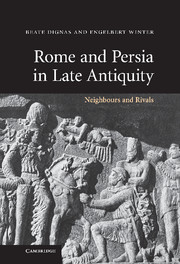Book contents
- Frontmatter
- Contents
- List of figures
- List of maps
- Preface
- Abbreviations
- Introduction: West and East, friend and foe, counterpart and mirror image …
- PART I NARRATIVE
- 1 Rome and Iran to the beginning of the third century ad
- 2 Rome and the Sasanian Empire: A chronological survey
- PART II SOURCES AND CONTEXTS
- Appendix 1 Lists of Sasanian kings and Roman emperors
- Appendix 2 Chronological table
- Appendix 3 Glossary
- Bibliography
- Index of sources
- Index of translated sources
- Index of names
- Index of place names
- General index
2 - Rome and the Sasanian Empire: A chronological survey
Published online by Cambridge University Press: 05 June 2012
- Frontmatter
- Contents
- List of figures
- List of maps
- Preface
- Abbreviations
- Introduction: West and East, friend and foe, counterpart and mirror image …
- PART I NARRATIVE
- 1 Rome and Iran to the beginning of the third century ad
- 2 Rome and the Sasanian Empire: A chronological survey
- PART II SOURCES AND CONTEXTS
- Appendix 1 Lists of Sasanian kings and Roman emperors
- Appendix 2 Chronological table
- Appendix 3 Glossary
- Bibliography
- Index of sources
- Index of translated sources
- Index of names
- Index of place names
- General index
Summary
THE THIRD CENTURY: THE ORIGINS OF SASANIAN INTERESTS IN THE WEST
The rise of the Sasanian dynasty, the revolt of Ardašīr I (224–40) against the Arsacids, the fall of Parthian rule and the foundation of the Neo-Persian Sasanian Empire (map 2) – together, these were not only a turning point within the history of Iran but also a benchmark regarding Iran's relations with Rome. Although Ardašīr's hostile attitude against Rome was at first a mere continuation of Parthian sentiments, within a few years of his reign the king established, consolidated and centralised his rule to the extent that his ambitions threatened wide areas of the eastern half of the Roman Empire. The West knew that Ardašīr's claims would go beyond the borders of the Parthian kingdom and that he would ask for more than declarations of loyalty from the many client kings within his empire; it was clear that he would claim all the territories that had once belonged to his Achaemenid ancestors. Rome therefore considered the Sasanian dynasty as a serious opponent right from the beginning of their relations (I).
As soon as Ardašīr had established his rule he turned towards the West. According to the contemporary historian Herodian, Ardašīr I responded to a letter from the Roman emperor Severus Alexander (222–35), in which the emperor warned him to respect peace and reminded him of the great victories of Augustus, Trajan and Septimius Severus, by asking Rome to withdraw altogether from Syria and Asia Minor.
- Type
- Chapter
- Information
- Rome and Persia in Late AntiquityNeighbours and Rivals, pp. 18 - 50Publisher: Cambridge University PressPrint publication year: 2007



